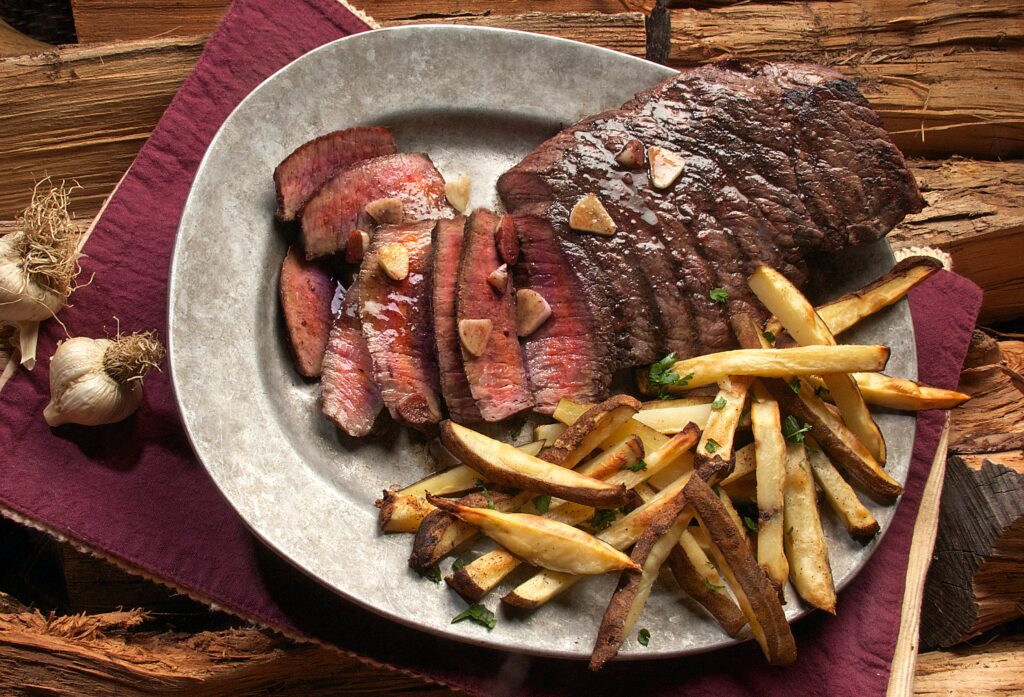Want to unleash your inner athlete and take your fitness game to new heights? Then you need to know about the secret weapon of champions – creatine!
However, do you have to rely on a supplement to achieve your fitness goal? Or you can get creatine from natural sources. Luckily, several foods high in creatine can supercharge your performance and give you the edge you need to dominate the competition!
So buckle up and get ready to learn about the muscle-building magic of creatine-rich foods.
8 Foods High in Creatine to Boost Your Performance
Creatine is a naturally occurring amino acid crucial in producing ATP, the primary energy source for muscle contraction during exercise. However, while creatine supplements are widely available and popular, some people prefer to get them from natural food sources.
Luckily, some of the best natural sources of creatine are right in your local grocery store.
Meats
| Item | Creatine/100 g |
| Beef | 0.5g |
| Pork | 0.4-0.5g |
| Poultry | 0.3-0.5g |
Seafood/Fishes
| Item | Creatine/100 g |
| Tuna | 0.4g |
| Salmon | 0.4g |
| Herring | 0.6-1g |
| Cod | 0.3g |
| Catfish | 0.25g. |
Source: Creatine In Natural Source
Here are 8 top-notch animal-based foods rich in creatine, along with tips on how to cook them to get the most out of their muscle-building benefits.

Meat
Let’s explore which meat can provide sufficient creatine to your daily diet.
Beef
This classic red meat is a real powerhouse of creatine, packing around 5 grams per kilogram of raw beef. However, the creatine content can vary depending on the cut of meat and the animal’s age, diet, and breed.
For example, grass-fed beef typically has higher creatine levels than grain-fed beef. You can get 0.9 to 1 gram of creatine from 100 grams of steak – indeed, good news for meat lovers!
In addition to creatine, beef is a good source of protein, iron, zinc, and vitamin B12, which are important for muscle building and recovery.
Pork
Pork does contain creatine, but relying solely on pork as a source of creatine may not be enough. Pork also contains other important muscle-building nutrients, such as protein, zinc, and iron.
Poultry
Poultry is a good source of protein and contains a small amount of creatine. The amount usually varies on the cut; the thigh supplies more creatine than the breast – around 13%. So, consuming chicken or turkey may not significantly impact your creatine intake.
If you want to increase your creatine intake, supplementing with creatine monohydrate may be more effective. However, don’t forget to consult with a healthcare professional before starting any new supplement regimen.
Fish and seafood
You can get creatine from fish and seafood.
Tuna
Well, while 100 g of tuna provides 0.4g of creatine, this may not significantly increase creatine levels for bodybuilding purposes. Most studies suggest that supplementing with 3-5 g of creatine daily can help support muscle growth and performance.
However, incorporating tuna into a balanced diet and a creatine supplement may benefit bodybuilders and athletes.
Salmon
Like tuna, salmon has creatine, but the quantity is not significant enough (0.4g to 100g) to be considered.
However, it’s a good source of protein, omega-3 fatty acids, and vitamins, which can support muscle building and recovery. While not a primary source of creatine, salmon is a nutritious addition to a muscle-building diet.
Herring
Herring contains creatine (0.6-1 g per 100 g), however, in smaller amounts than red meat. While it can contribute to your overall creatine intake, it may not provide enough to impact muscle building or athletic performance on its significance.
Cod
You can get a small amount of creatine from cod – 0.3 g in 100 g of serving. Though the amount is significantly low, they are a good source of protein, omega-3 fatty acids, and vitamin D. Besides, cod is high in lean protein and rich in phosphorus, which promotes a healthy weight.
Catfish
While catfish may contain trace amounts of creatine (0.25g per 100g), it is unlikely to provide enough creatine to meet daily requirements, especially for fitness enthusiasts. But catfish is a good source of protein and other nutrients, such as vitamin B12 and omega-3 fatty acids, promoting overall health and supporting muscle-building efforts.

Are Plant-Based Foods High In Creatine?
No, plant-based foods are not high in creatine. Creatine is a naturally occurring compound containing nitrogen commonly found in animal products like meat, fish, and poultry.
Further, creatine is primarily synthesized in the liver and kidneys from three amino acids: arginine, glycine, and methionine, which are abundant in animal but not plant tissues.
While some plant-based foods like seeds and nuts contain small amounts of creatine, the levels are insufficient to provide sufficient creatine to vegetarians.
Is there a creatine food source for vegans or vegetarians?
There are no significant dietary sources of creatine for vegans or vegetarians, as creatine is primarily found in animal-based foods.
However, some plant-based sources like spinach and nuts contain small amounts of creatine, but they are not significant enough to provide the same benefits as animal-based sources. Vegans and vegetarians interested in supplementing with creatine can use synthetic or plant-based creatine supplements to ensure adequate intake.
Are Milk And Eggs Good Sources Of Creatine?
While eggs and milk contain small amounts of creatine, they are not considered significant sources of this nutrient.
Milk contains about 0.1 grams of creatine per kilogram of milk.
Similarly, a large egg contains about 0.005 grams or 5 milligrams of creatine.
However, these amounts contribute slightly to your daily creatine intake, almost insignificant.
Does Cooking Affect Cretaine Level in Food?
Cooking can affect the creatine level in meat, fish, or seafood. Studies have found that high-heat cooking methods can break down creatine and increase creatinine, a waste product that can lead to kidney disease.
Cooking methods like grilling, frying, or baking are mainly responsible for decreasing creatine levels. Though a little, boiling can preserve creatine levels in food. However, there’s always a chance of the creatine leaching out into the cooking water.
Is Creatine From Food Enough?
While you get enough creatine from red meat, poultry, fish, and seafood, it’s insufficient to boost your athletic performance. Besides, getting sufficient creatine from food alone can be more challenging if you follow a vegetarian or vegan diet. In that case, you may need creatine supplements.
For individuals who engage in high-intensity exercise – weightlifting or sprinting – supplementing with creatine can provide additional benefits. Even The International Olympic Committee (IOC) and the National Collegiate Athletic Association (NCAA) permit using creatine among athletes.
You can mix creatine with several foods, like overnight oats or juice, to make it healthier and more effective.
However, it’s always best to get nutrients from natural sources first, and while starting any supplementation, consulting your physician is the first thing to do.

Benefits of Consuming Foods High in Creatine.
Here are some potential benefits of consuming foods high in creatine.
Athletic performance
Creatine helps regenerate ATP (adenosine triphosphate), the primary energy source for muscle contractions. By increasing the amount of ATP available, creatine can improve athletic performance, particularly during high-intensity, short-duration activities such as weightlifting, sprinting, and jumping.
Muscle mass
Creatine has the potential to promote the growth of new muscle fibers and boost the water content of muscle cells, which can lead to an increase in muscle size. Eating foods that are rich in creatine may also have a similar effect.
Cognitive function
Foods containing creatine may enhance cognitive functions, including memory, attention, and processing speed, by increasing the energy supply to brain cells.
Neuroprotective effects
Creatine-rich food might possess neuroprotective properties, implying that it can safeguard the brain against harm and illnesses.
Risks Associated With Consuming Creatine-Rich Foods
While creatine-rich foods are typically safe for most individuals, consuming excessive amounts can carry potential risks.
Consuming very high doses of creatine-rich foods may lead to discomfort in the gastrointestinal tract, dehydration, and kidney damage. Furthermore, some individuals may be more sensitive to creatine, which could lead to side effects such as muscle cramping, nausea, and diarrhea.
Bottom Lines
Are you looking for foods high in creatine?
From red meat to seafood to dairy products, plenty of delicious options exist where you can get creatine. But if you’re serious about packing on muscle, these foods alone may not cut it. Consider adding a creatine supplement to your routine after consulting with your doctor.
With the right fuel and extra help, you’ll be well on your way to achieving your muscle growth dreams.

I started my professional career as a sports medicine consultant in Rola, Missouri. My primary role was to suggest suitable supplements for my patients according to their pre-existing conditions and lifestyle goals. I believe a healthy lifestyle is the most important if you want to make your life really meaningfull.

